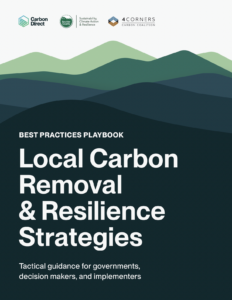Boulder County has collaborated with Carbon Direct, a carbon management company with deep expertise in climate science, data, and policy, to create a playbook for developing local carbon dioxide removal strategies.
Carbon Removal Strategies for Local Government


“Best Practices for Local Carbon Removal and Resilience Strategies” and a companion report, “Carbon Removal Strategies for Local Communities” are available to download.
What is Carbon Dioxide Removal?
Carbon dioxide removal (CDR) is a set of technologies and techniques designed to remove carbon dioxide from the atmosphere. CDR takes carbon from the atmosphere and stores it in various forms such as soil, underground reservoirs, forests, kelp, or synthetic materials like concrete. There are various methods, such as afforestation (planting new trees), reforestation (restoring forests), soil carbon sequestration, direct air capture of carbon dioxide, and more.
Why is CDR important?
The International Panel on Climate Change estimates that even in the most optimistic greenhouse gas emissions reductions scenarios, carbon removal will need to scale to multiple gigatons per year by mid-century to meet climate targets. Even if we achieve net zero emissions globally by 2050, a safe and healthy climate will still require the ongoing removal of legacy emissions from the atmosphere at similar or greater scales through the end of the century.
Local governments have an important role to play in scaling CDR. They understand the unique impacts of climate change in their own community. They also know local opportunities for innovation and economic development. The work to scale CDR has already started in Boulder County where the county’s Climate Innovation Fund supports local carbon removal projects.
Additionally, Boulder County partnered with Flagstaff, Arizona, Salt Lake City, Utah, and Santa Fe, New Mexico to found the 4 Corners Carbon Coalition. This group of local governments pools resources to accelerate CDR projects in their own communities.
Local Carbon Removal in Action
These videos profile local carbon dioxide removal innovation projects supported by the 4 Corners Carbon Coalition.

